
Original Link: https://www.anandtech.com/show/3956/toshiba-a6653dv-nvidia-3d-vision-notebook
Toshiba A665-3DV: 3D or Not 3D?
by Jarred Walton on October 6, 2010 12:05 AM ESTToshiba A665-3DV: 3D or Not 3D?
Let's start by getting this out of the way: to the naked eye—outside of some stickers on the palm rest informing us otherwise—the A665-3DV is identical to the A660D we reviewed last month. It has the same chassis, speakers, keyboard, touchpad, etc. We'll simply refer back to that review for our extended discussion of the aesthetics and design, because we've already got plenty to talk about. Of course, while the exterior is the same (outside of a switch to a 120Hz LCD, which we'll cover in a moment), the internal components are a different story.
| Toshiba Satellite A665-3DV Specifications | |
| Processor |
Intel Core i7-740QM (4x1.73GHz, up to 2.93GHz Turbo, 45nm, 6MB L3, 45W) |
| Chipset | Intel HM55 |
| Memory |
2x2GB DDR3-1066 (Max 2x4GB) (Samsung DDR3-1066 @ 7-7-7-20 1T) |
| Graphics |
NVIDIA GTS 350M (96 CUDA Cores, 450/1080/1580MHz Core/Shader/RAM) |
| Display |
15.6" LED Glossy 16:9 120Hz 768p (1366x768) Chi Mei (CMO) LCD—unknown model |
| Hard Drive(s) |
640GB 5400 RPM Hard Disk (Toshiba MK6465GSX) |
| Optical Drive |
Blu-Ray Combo Drive (Matshita UJ240ES) |
| Networking |
Broadcom RTL8168/8111 Gigabit Ethernet Broadcom 802.11b/g/n Wireless LAN |
| Audio |
Realtek ALC269 HD Audio Harmon Kardon stereo speakers Headphone (shared with optical) and microphone jacks |
| Battery | 12-Cell, 10.8V, ~8300mAh, 98Wh battery |
| Front Side | MMC/SD/MS/xD Reader |
| Left Side |
ExpressCard/34 slot USB 2.0 eSATA/USB 2.0 combo port (with Sleep and Charge) HDMI Ethernet jack VGA Exhaust vent |
| Right Side |
Microphone/headphone jacks 2x USB 2.0 Optical drive AC jack Kensington lock |
| Back Side | Nothing |
| Operating System | Windows 7 Home Premium 64-bit |
| Dimensions | 14.98" x 10.0" x 1.18-2.31" (WxDxH) |
| Weight | ~6.6 lbs (with 12-cell battery) |
| Extras |
NVIDIA 3D Vision Kit Webcam 101-key LED backlit keyboard with 10-key Flash reader (MMC/MS/MS Pro/SD/xD) |
| Warranty | 1-year standard warranty |
| Pricing |
$1599 MSRP Online starting at $1400(9/28/2010) |
This is actually quite interesting on one level. We complained about the 450MHz GPU clock on the HD 5650 GPU in the A660D, and here we have much hotter and higher performing parts in the same basic chassis. Obviously, the lower GPU clock on the A660D wasn't a matter of heat, because the A665-3DV manages to cool a GTS 350M along with a far more power hungry i7-740QM. (Note that the GTS 350M in this notebook also appears to have a lower clock than normal; NVIDIA specs the chip for 500 Core/1250 Shader, but CPUZ and GPUZ report the above 450/1080 instead. I guess Toshiba has a habit now of downclocking GPUs—or buying cheaper units that can't run at the normal speed perhaps?) But we're not here to lament the decisions made on the A660D, are we? Besides the CPU and GPU, we have the obligatory 2x2GB DDR3 memory, a large 640GB 5400RPM Toshiba hard drive, and a Blu-ray/DVDR combo drive. The backlit keyboard is still a welcome addition, even if we're not so keen on the feel (i.e. glossy keys). Better than average speakers and a webcam round out the package. Of course, we're here for the 3D Vision, right?
This is a first generation 3D Vision notebook. What's that mean? It means the 3D emitter is a separate USB device just like on desktops. There are next generation 3D Vision notebooks coming this fall (Acer's recently announced Aspire 5745DG for example, scheduled for availability later this month) with the 3D emitter built into the LCD bezel. If you're ready to buy into the whole 3D experience, integrating the emitter is definitely the way to go. Right now, if you want to take your laptop on the road, you'll need the power brick and cable, your 3D glasses, the 3D emitter, and possibly an extra USB cable to charge your glasses (though you can use the cable for the emitter). That's quite a bit of extra "stuff" to carry around, and you'll also need space to set the emitter when in use. If you have an NVIDIA desktop GPU and a 120Hz LCD, you can use the same 3D Vision kit that comes with the A665-3DV on both systems, but that's about the only positive for the separate emitter.
We also had some issues with periodic flickering of the glasses—it felt like the shutters weren't syncing up properly; usually it cleared up after going into the NVIDIA control panel and setting things up again. Several times we also got a message in red saying the display wasn't 3D Vision ready, even though it obviously is. Again, doing the setup for 3D Vision would fix the problem. Another complaint is that despite having a 120Hz panel, there are certain transitions where the LCD doesn't respond fast enough, so you get a dim "double vision" effect. This was most prevalent on sharp contrast objects like a dark brown pole/building against a blue sky. So the "2ms" response time claims seen on 120Hz panels remain suspect; they're a best-case result with some transitions obviously requiring more than 8.3ms. Having said that, the 120Hz refresh rate is definitely appreciated, even if you never use 3D mode.
Finally, let's talk about performance. 3D Blu-ray worked fine in our testing, but you'll need the appropriate software to make it work. The included free Toshiba BD Player didn't support 3D playback when we started testing, but Toshiba released an updated version last week; we tested the latest version of PowerDVD 10 for the review, along with the Toshiba WinDVD 3D update. We didn't have an external 3DTV or display for testing, but such configurations are supposed to work with the latest NVIDIA drivers, and 3DTV Play support means you can even use your HDTV's glasses and hardware if you have it. While the multimedia aspects of 3D were fine, 3D gaming is a different story. We tested all the current crop of "3D Vision Ready" titles to see how they fared. At medium details and the native 768p resolution, only Batman: Arkham Asylum and Resident Evil 5 managed to break the 30FPS barrier; drop to minimum detail and Battlefield: Bad Company 2 squeaks by. Most of the other titles start at around 20 FPS, at minimum detail, and go down from there. Obviously, much more than a GTS 350M is required if you're serious about 3D Vision gaming.
Since we've already reviewed the A660D, there's not a lot new to say here. If you thought the A660D's plastic chassis was cheap, it's even worse in a $1400 notebook. Really, manufacturers that plan to use the same basic design in a large range of laptops should build for the higher quality market and let it trickle down. We thought the A660D was somewhat overpriced as well, unless you really need the ExpressCard port, so a chassis that feels more durable would work with the lower end A66x offerings as well. While it's not a terrible design, it's somewhat reminiscent of Clevo's high-end notebooks and their frequently chintzy look and feel. With the basics out of the way, we're going to jump right in to the benchmarks and performance.
Toshiba A665-3DV with 3D Multimedia
It would be great if doing 3D Vision was as easy as regular computer tasks, but that's not the case. As we'll see in a moment, running games in 3D Vision mode often comes with a huge performance hit that's more than the GTS 350M can handle. Perhaps that's why Toshiba is billing the A665-3DV as more of a multimedia 3D platform than a gaming 3D platform, so we felt it would be good to start with a look at the multimedia aspects. There are really just two kinds of media to consider here: movies and images. Let's start with the latter, as it's a bit easier.
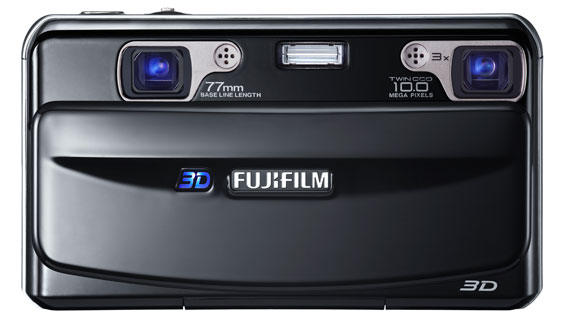
As part of the review, NVIDIA shipped us a Fujifilm Real 3D W1 camera. We're not going to turn this into a camera review (frankly, I'm not the right guy for camera reviews!), but the basic concept is easy enough: instead of one lens and sensor, put two into a camera and now you can take 3D pictures. The lenses on the W1 are set about eye width apart, so in default mode you can now capture a 3D stereoscopic image at the snap of a button. Cool! The LCD on the rear of the camera allows you to see the 3D effect, but it's a low resolution affair that doesn't really capture the experience. The 3D images are stored in an MPO format, along with an optional JPG from the left lens, and NVIDIA's 3D Vision Photo Viewer can display the files on your laptop. If you want a full review of the W1, for now I'll just refer you to this photographyblog review that covers the salient details. The W1 works as advertised, and honestly some of the pictures can look really cool. The movie mode wasn't as useful in my experience, as it's quite noisy and only captures at 640x480, but if you're a 3D enthusiast I'm sure you can have some fun with it.
Okay, back to the discussion of 3D images. Using a camera (or downloading sample images from the web), you can get some really cool stereoscopic images that really have depth. If you've ever looked at Magic Eye pictures and thought, "okay, neat, but a bit of a head throb", 3D images with glasses provide a far more impressive result, with no need to spend several minutes trying to figure out what you're looking at. I let my daughter run wild with the W1 for a while, and then we looked at the pictures she captured. Some were blurry, some were too close to the subject and "broke" the 3D effect, but a lot of them were quite good. It's a fun tchotchke at the very least… fun but quite expensive. Still images also cause less eyestrain for me, as you can take your time and examine the image.
Movies take the above and add motion, which can be a bit disorienting for some people. If you've ever been to a modern 3D movie (i.e. Toy Story 3 in 3D), you know what to expect. The experience of watching 3D movies on the A665-3DV is very similar, though as noted earlier there are certain color transitions that bleed over slightly from one eye to the other because of a less than perfect pixel response time. The 3D movie experience depends largely on the quality of the 3D movie, though, so some movies look like there are a few flat planes where the action takes place, while others offer more of a contiguous 3D experience where there aren't discrete planes. (Note that 3D movies made with the W1 camera fall into the latter category, thanks to the use of two discrete lenses.)
I actually find 3D movies sort of cool, but not enough that I'm willing to shell out an extra $5 at the theater, $300 extra for a 3D laptop, or $500 for a 3D camera. At the end of a two-hour 3D movie, my eyes also feel tired and I'm definitely ready for a break from 3D. Our former editor Derek Wilson would typically hit max tolerance for 3D after just 30 minutes or so, while others aren't bothered by the experience at all. If you happen to be part of the movie-going crowd that watches every possible film in 3D, you'll probably like—or at least be more receptive to—the idea of a 3D notebook. If you can find some good 3D streaming video or 3D broadcasts (i.e. the recent World Cup in 3D), so much the better. Sadly, that's easier said than done, what with network provider exclusives and other shenanigans.
Toshiba addresses that last problem (sort of) with their 3D Video player, which allows the enhancement of DVDs to produce a 3D effect. (I believe there's a similar image viewer in the works, but it wasn't available at the time of writing.) The result isn't the same caliber as a true 3D movie, with some scenes getting the 3D wrong, but I have to say: the fact that they can even make it work at all is impressive. There's some serious image analysis and processing going on to convert a 2D video into a faux-3D video in real time. As impressed as I am that this sort of enhancement can be done, I have to say I prefer sticking with the standard mode for DVDs—or perhaps enabling the Toshiba DVD player's alternate "upconvert" mode that applies a sharpening filter to DVDs to make them look better on HD displays.
The quick summary of the 3D multimedia experience is that, short of holographic displays, the 120Hz 3D Vision experience is about as good as we're going to get for a while. The only problem is that when you're dealing with a 3D notebook (or computer), you're generally limited to experiencing 3D by a single person at a time. If you have multiple pairs of shutter glasses, you could have more than one person watch a 3D movie with you, but with a small 15.6" notebook screen it's not nearly as compelling an argument as watching a 3DTV together. I don't have any external 3D displays or a 3DTV for testing, so unfortunately I can't comment on how well that does or doesn't work, but that's partly because what I've seen so far isn't enough to get me to buy in to the technology. It's cool for a while, but at the end of the day it feels more like a gimmick.
I've read suggestions that 3D isn't helping the movie industry, that fewer people are going because of the higher prices, and that the only reason Hollywood pushed for 3D was as a way to get the theaters to convert to digital, which would save tons of money in distribution costs. Maybe the problem is that people just weren't impressed with this summer's 3D blockbusters. If you like 3D video, have a 3DTV, and are excited for the all the current and upcoming 3D Blu-ray releases, adding a 3D notebook to the fray is the next step; but I think the number of users that fit that description is limited at best. If you're mostly interested in multimedia 3D, I'd also recommend finding a 1080p 120Hz LCD to go with the 3D Blu-ray experience.
What About 3D Gaming?
I've already spoiled the surprise and stated up front that 3D gaming on this particular system is not going to make the cut. Outside of a few titles, most games have frame rates cut in half by enabling 3D, which means even at low/minimum detail there are plenty of titles that can't break the 30FPS threshold—that's not even highly fluid, but at least most people will consider 30FPS decent. Even with a low resolution 768p display, the GTS 350M is an albatross around 3D Vision's neck, and NVIDIA knows this. If you really want a 3D notebook, my advice would be to get something that's at least twice as fast as the GTS 350M, and three or four times faster would be ideal. You know, something like the GTX 480M (in SLI if you're really shooting for the stars).
In order to get an idea of the 3D Vision Gaming experience, we went to NVIDIA's site and looked at all the 3D Vision Ready titles. These are the games that are built from the ground up to support 3D Vision, which means 3D should just work out of the box without any extra work. Other titles might require you to disable motion blur or certain effects for an optimal 3D experience. So, we rounded up copies of all the games on that list, which is pretty easy since at present there are only seven actual games. We then tested each game at low, medium, and high detail settings at the native 1366x768 LCD resolution, with and without 3D enabled. Yeah, we're gluttons for punishment. Here are the results.
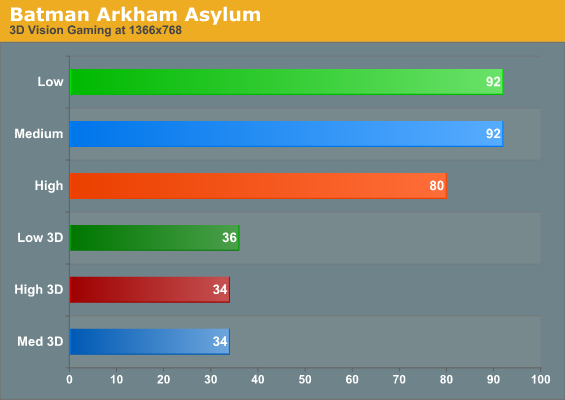
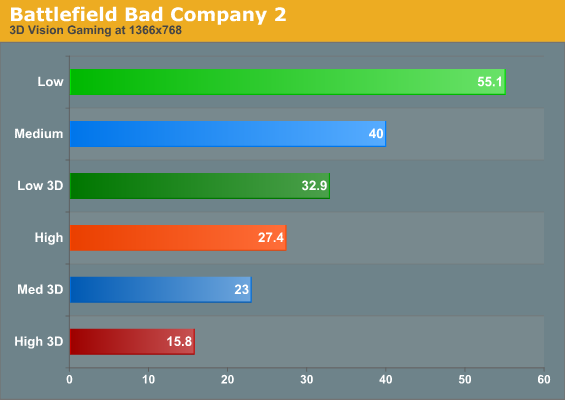
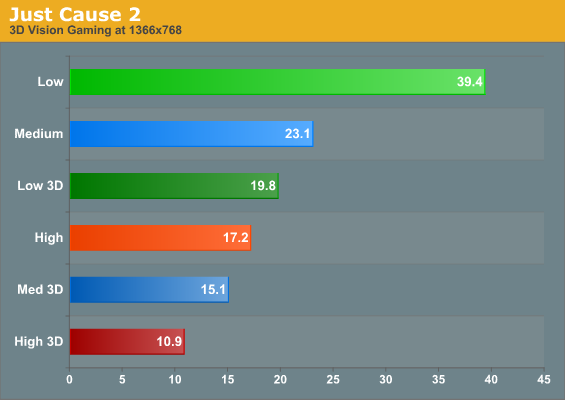
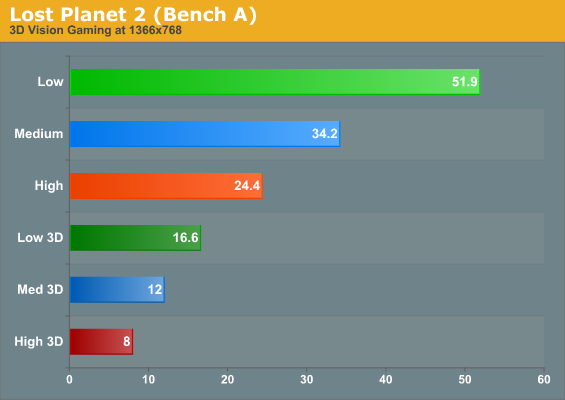
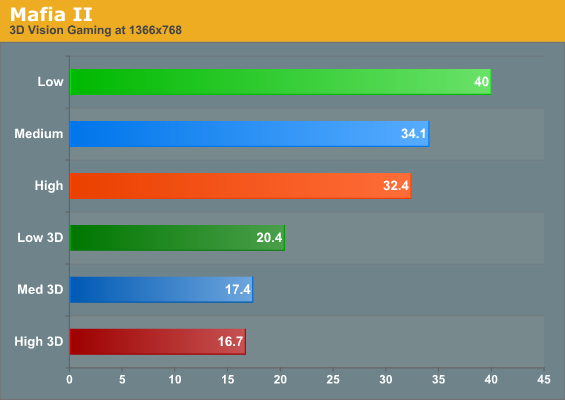
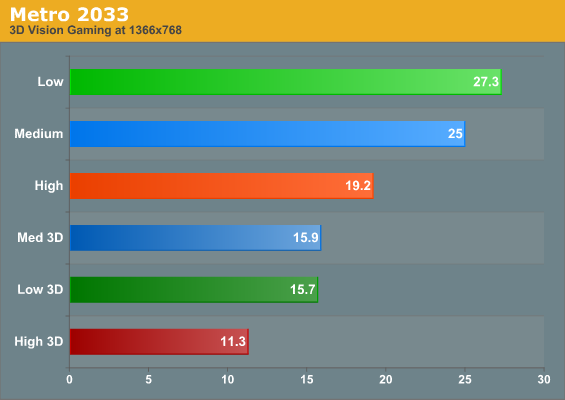
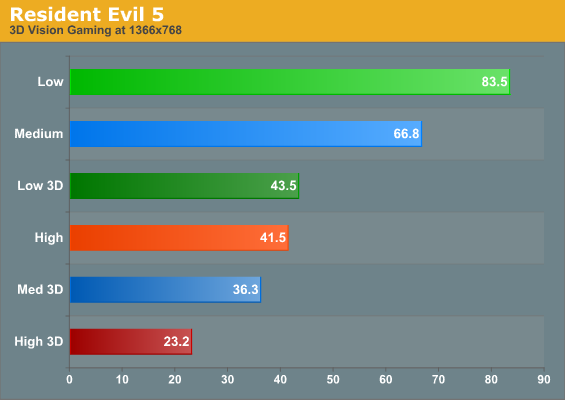
Out of the 3D Vision Ready games, only Batman is able to reach 30FPS at higher detail settings (note that NVIDIA recommends turning off motion blur for 3D Vision). As a game with no crosshair, Batman also lends itself very well to the 3D experience and was the most enjoyable of the titles. Resident Evil 5 also manages to post decent frame rates at medium detail. We should mention that there are still scenes in both of these games where your performance will drop into the teens, so even though the average frame rates are acceptable you may want to use the CTRL+T shortcut to disable 3D Vision at times. BFBC2 also breaks the 30FPS mark at minimum detail, and the 3D effects look good while doing it, but the graphics quality overall takes a pretty sharp dive at "low" compared to "medium". The rest of the games definitely don't reach playable performance with 3D Vision. It's too bad, because after hearing Brian say how cool Metro 2033 was in 3D, I couldn't do much other than watch the 15FPS slide show and wish for a faster GPU. It was a very nice looking slide show, though.
There are a lot more "Excellent" and "Very Good" 3D Vision games on the list, and we obviously didn't test the majority of those. If our pattern holds, you can probably estimate losing half your performance with 3D enabled, which means you'll want to use game setting combinations that can run at over 60FPS normally (and preferably closer to 100FPS). However, there's no guarantee it will only be half. Left 4 Dead 2 (a "Good" game) runs 3.6 times faster at low detail without 3D, and STALKER: Call of Pripyat runs 3.1 times faster (at Low + Object Lighting) without 3D. If you really want a 3D Gaming notebook, I think the GTX 460M is probably the minimum I'd recommend at this point—and that's for a 768p display. If you want 1080p in 3D, you'd better plan on going the full Monty and grabbing a GTX 480M (probably even 480M SLI), or else you'll be turning graphics settings way down to get acceptable performance.
The Rest of the Story: Application Performance Compared
Besides all the 3D stuff, we ran our usual suite of benchmarks. The i7-740QM is a newer CPU with slightly higher clocks than the 720QM it replaces. In fact, other than a slightly lower maximum Turbo speed and 6MB rather than 8MB L3 cache, it's about the same as the i7-820QM (which has since been superseded by the i7-840QM). Overall application performance is thus plenty fast, and if you happen to have a multi-threaded application that you run regularly, quad-core Intel CPUs are the fastest mobile option right now—by a large margin. Here are the results of our application testing.
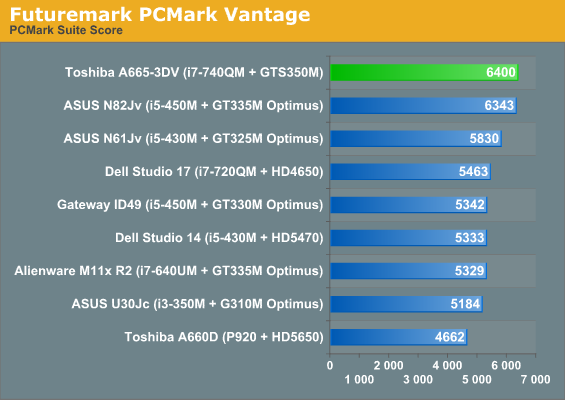
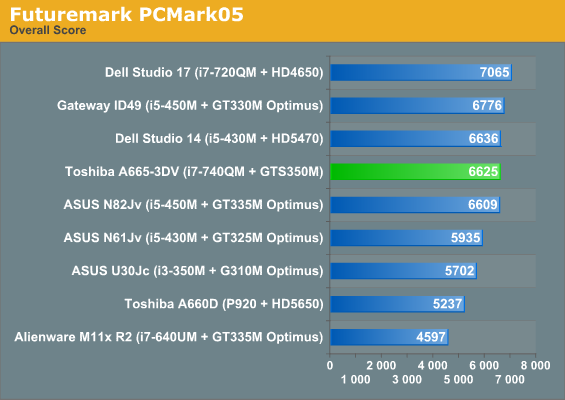
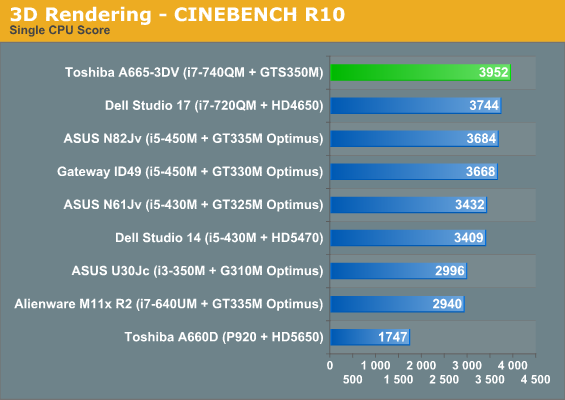
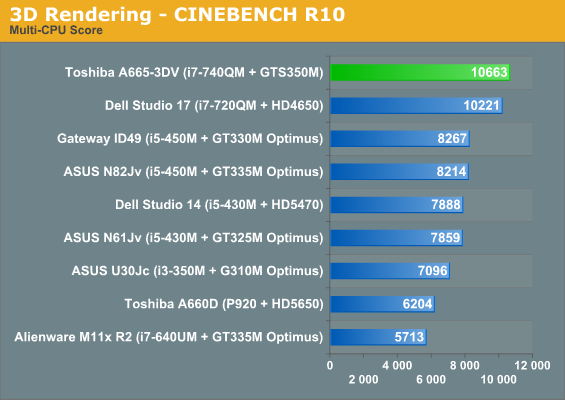
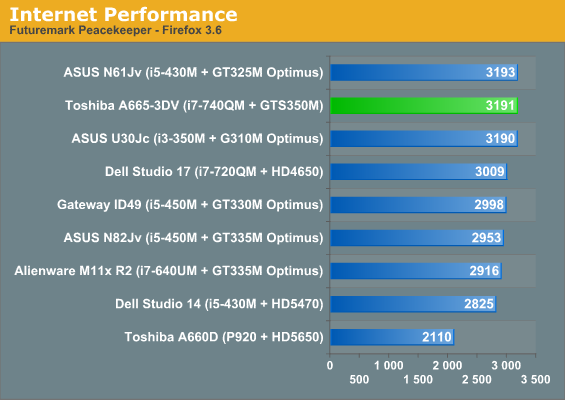
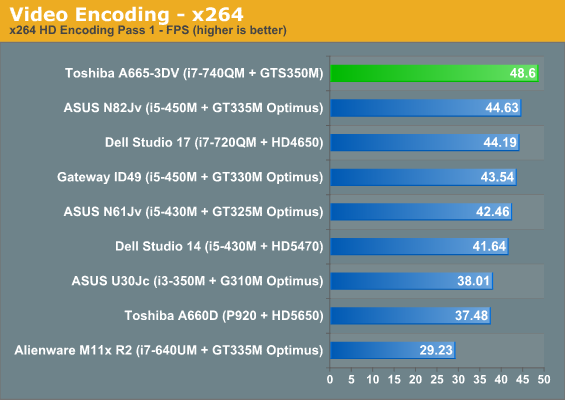
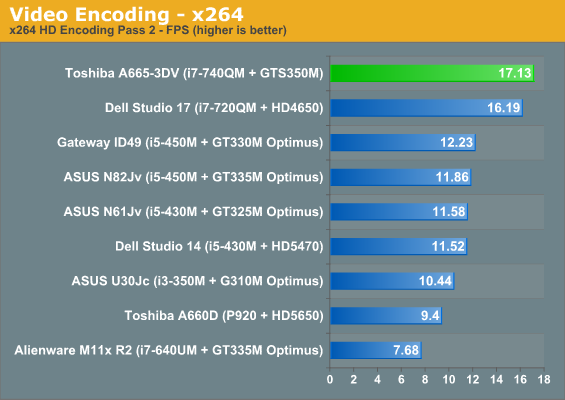
PCMark ends up being a case of six of one, half a dozen of the other in terms of which laptop is fastest. Higher-clocked dual-core processors can compete with the i7-740QM, but all it really takes to bring in an extreme score is the addition of a good SSD. The Toshiba ekes out a victory, with the ASUS N82Jv coming in just a fraction behind in our "midrange" notebook comparison, but it falls slightly behind the Gateway ID49C and Dell Studio 17 in PCMark05 (which is very long in the tooth these days). Peacekeeper also has the 3DV "tied" for the lead, and as a single-threaded benchmark that's something worth noting. Incidentally, we're looking to retire Peacekeeper and replace it with a more relevant benchmark, so if anyone has a recommendation, sound off in the comments!
Moving to the more strenuous CPU tests, the i7-740QM comes into its own in Cinebench and x264 encoding, scoring clear victories in both. As expected, second place in these tests goes to the other quad-core Intel CPU, the i7-720QM, with the heavily threaded Cinebench SMP and 2nd pass x264 outpacing even the faster dual-core parts by 30-40%. If you're looking for a notebook that can do heavy multimedia work—power requirements notwithstanding—the Clarksfield processors are the clear choice. Or at least they are until Sandy Bridge shows up later this year/early next year.
Comparative Gaming Benchmarks
What follows is a core dump of all the gaming results, at low, medium, and high detail settings (as determined by our testing). All of the games are technically 3D Vision capable, though some have lesser ratings—i.e. DiRT 2 is listed as "Poor". The only reason we're including the Low detail settings on the A665-3DV is so we can give yet another look at 3D Vision capability. We'll include the 3D score for each of the titles. Along with DiRT 2's "Poor" score, note that Mass Effect 2 is rated "Fair" while StarCraft II and Left 4 Dead 2 have a "Good" rating. STALKER: Call of Pripyat isn't in the official list, but the benchmark lists it as "Excellent" and detects it as STALKER: Clear Sky. Let's first look at the Low gaming results.
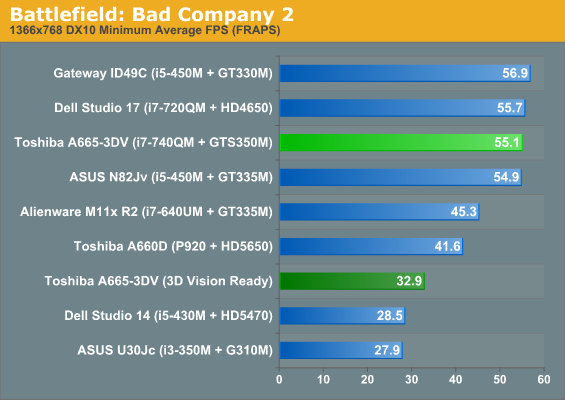
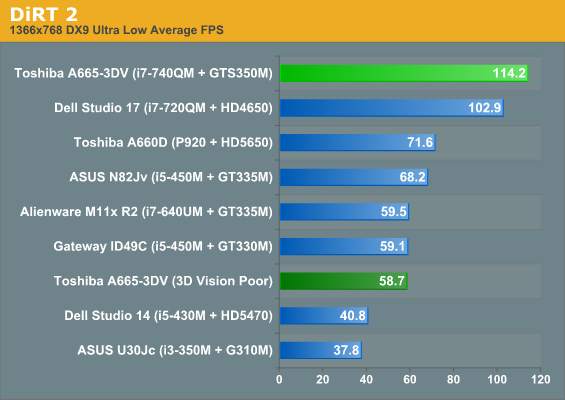
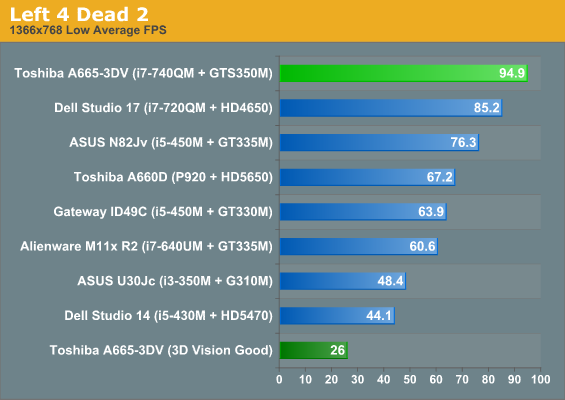
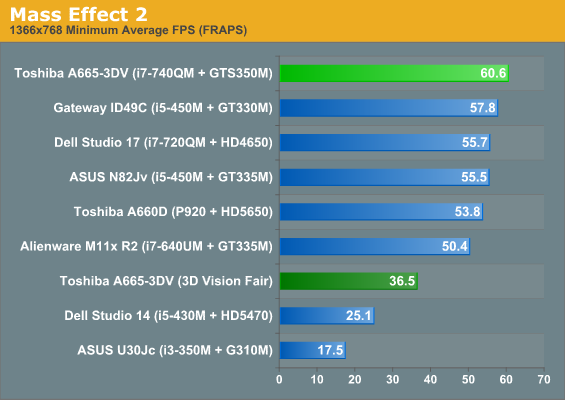
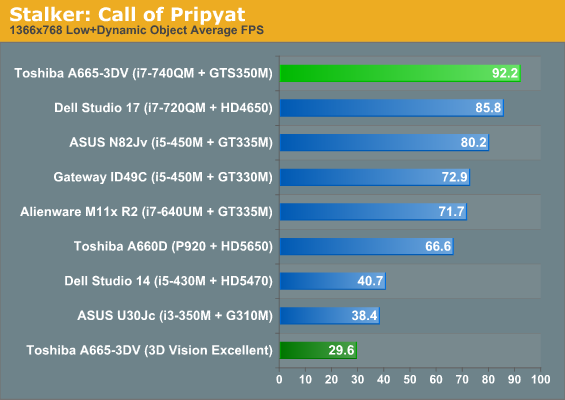
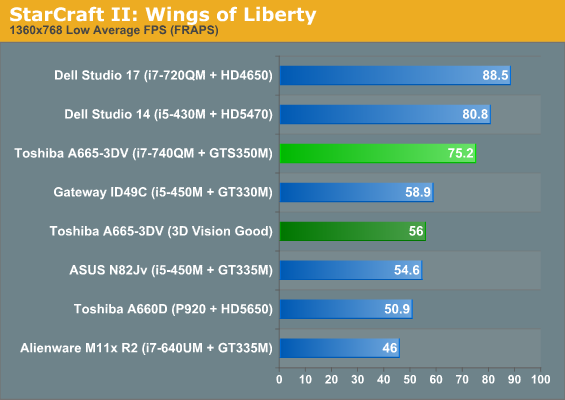
First, let me state that while many of the games rate less than acceptable for 3D Vision, I actually thought most looked fine at our low quality test settings—many of the effects that break the 3D look are not enabled. DiRT 2 for instance looked better than some of the other games I thought, despite a "poor" rating. StarCraft II on the other hand is absolutely not a game I'd play in 3D. The buildings seem to "float" and the 3D effect is distracting at best. STALKER: Call of Pripyat (at least the benchmark version we use) had some clear issues, with a sort of lurching feel in 3D mode. I would disqualify the score, and perhaps the full game shows better performance than what we experienced, but NVIDIA recommends setting lighting to "static" which largely disables all of the better graphics effects. (We tested with lighting enabled, so perhaps that explains the "lurching".)
As far as non-3D performance goes, the GTS 350M manages to top the charts in nearly every one of our games. BFBC2 is one game where a couple other laptops are able to hang with the A665-3DV, and it may be a case that it has a graphics memory bandwidth bottleneck (the 350M has the same 128-bit GPU RAM bus clocked at 1580MHz as the GT 330M/335M). StarCraft II is the other exception to the rule, with the ATI-based laptops posting clearly higher numbers. It may be that those laptops were using an older driver that didn't render everything properly, however, so take the scores with a grain of salt. There's really no reason why HD 5470 or HD 4650 should ever outperform the GTS 350M if they're doing the same workload.
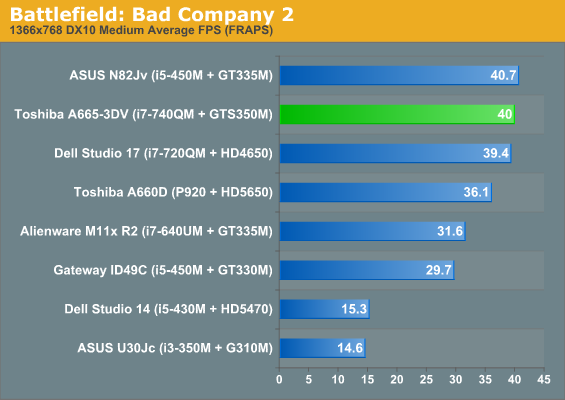
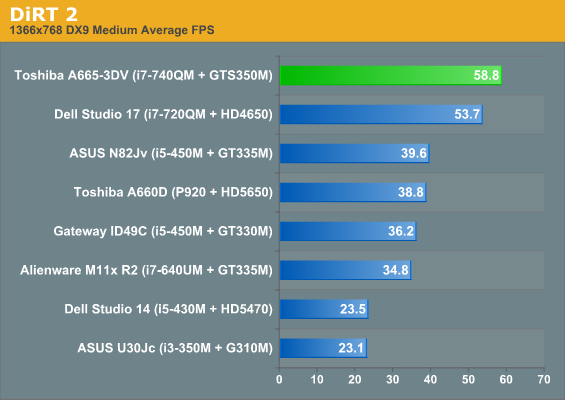
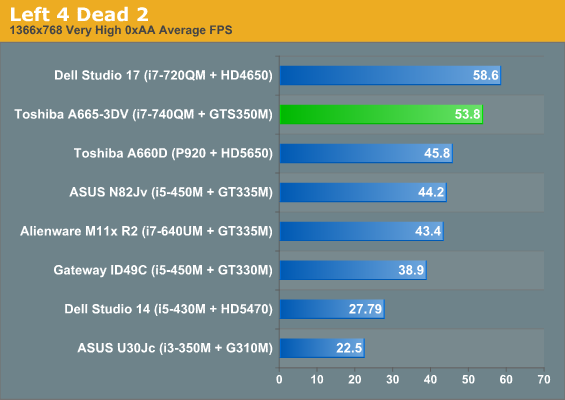
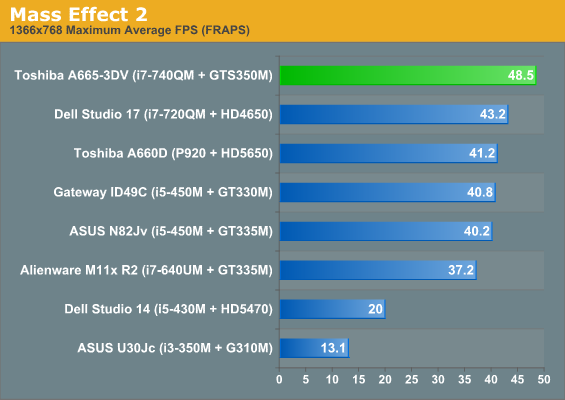
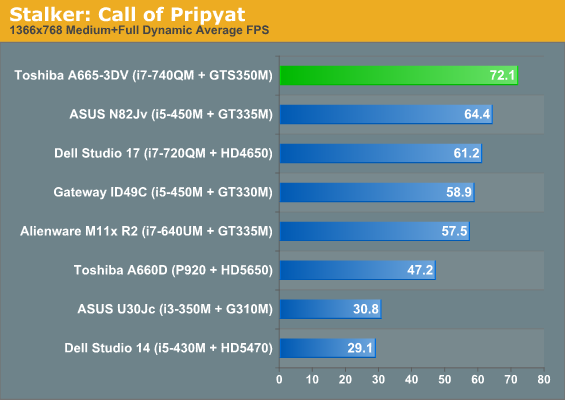
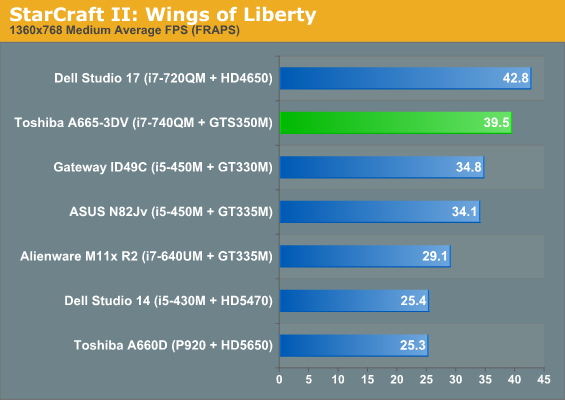
Crank things up to medium detail and the GTS 350M continues to post playable results in all of our titles. We're at or above 40FPS across the board, and this is really the sweet spot for the A665-3DV. BFBC2 and SC2 still show some performance oddities as discussed above, likely for the same reasons. In case you're wondering, we did run some of the 3D Vision results, but the only game to break the 30FPS mark with 3D and "medium" detail from our suite is DiRT 2. Unfortunately, at medium a bunch of the graphics effects start to interfere with the 3D experience.
High Detail Gaming
Wrapping up the gaming side of things, here's a look at what happens when we run at high detail settings. We've tested at the native 1366x768 resolution, but we also connected an external LCD to show how the GTS 350M compares to some of the higher-spec mobile GPUs.
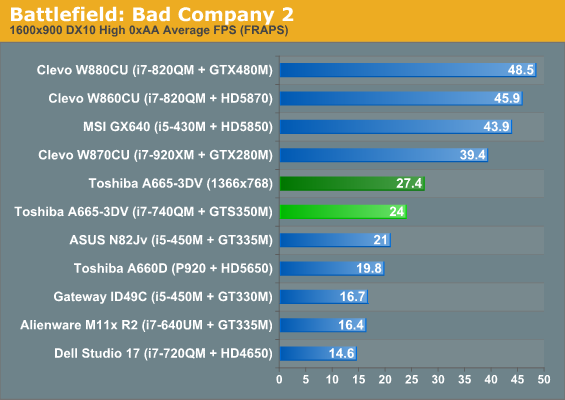
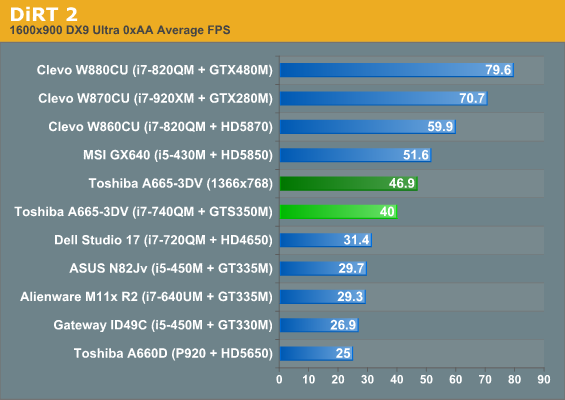
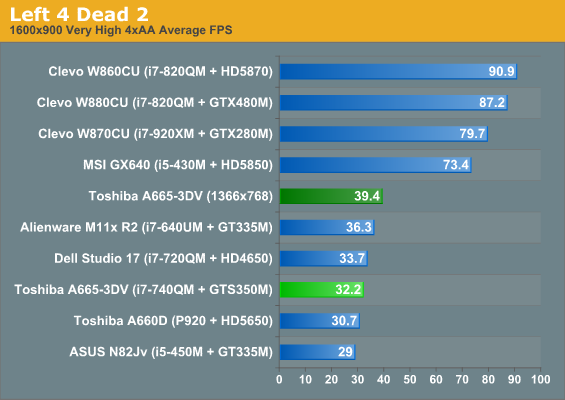
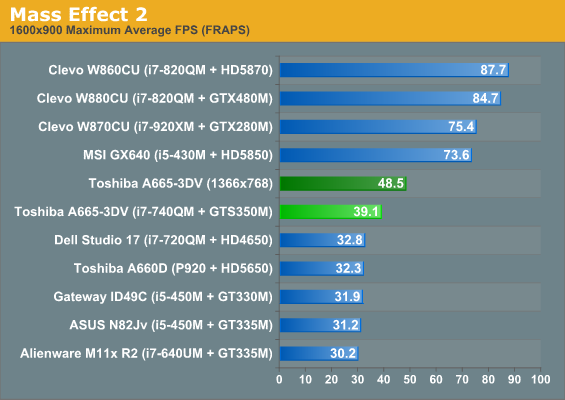
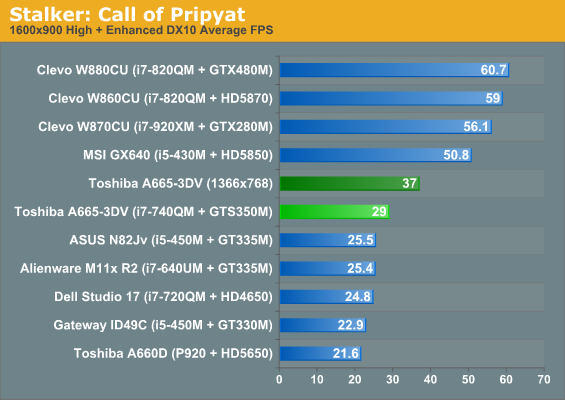
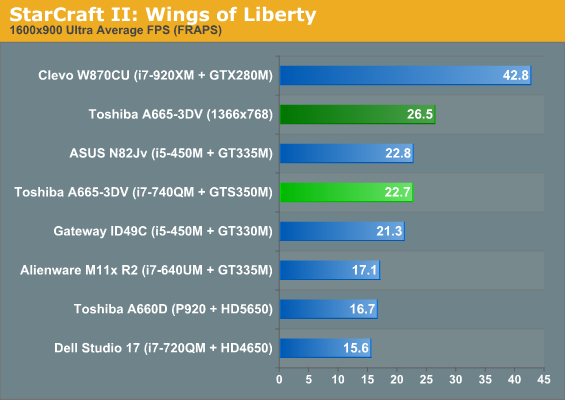
Four of the six games continue to post playable frame rates at 1366x768 with high detail settings. BFBC2 and SC2 are the odd men out, dropping just below 30FPS in both cases. There are no performance anomalies this time either, as the 350M takes its rightful place among midrange mobile GPUs. Unfortunately, that place is quite a big step down from high-end offerings like the HD 5850 or even the venerable GTX 280M.
Compare the standardized 1600x900 results (not including StarCraft II where we lack results for most of the high-end notebooks) and the GTS 350M is roughly half the performance of the GTX 280M, 55% of the HD 5850, and less than half of the HD 5870 and GTX 480M. GTS 350M is also pretty much EOL now, due to be replaced by the GT 445M. As long as you get the 192-bit bus, the GT 445M should boost performance quite a bit; now all we need is some laptops with the new 400M chips.
3DMark Performance
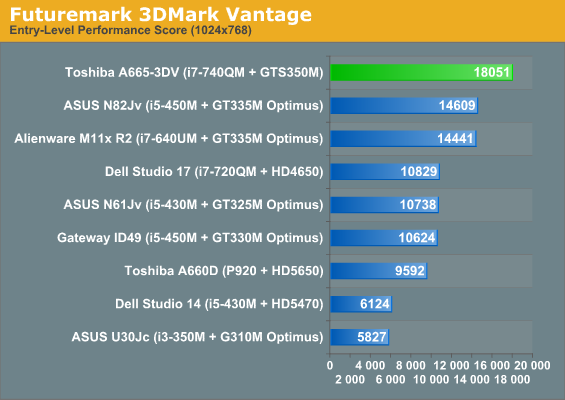
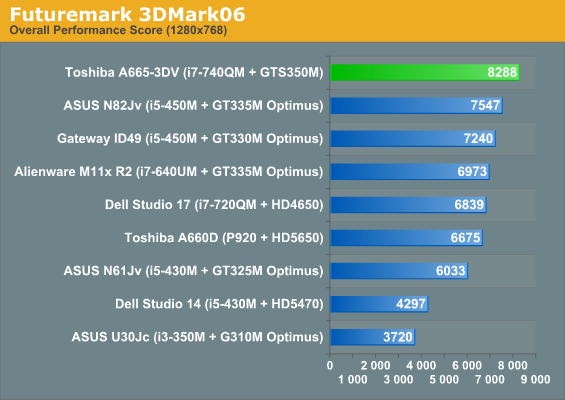
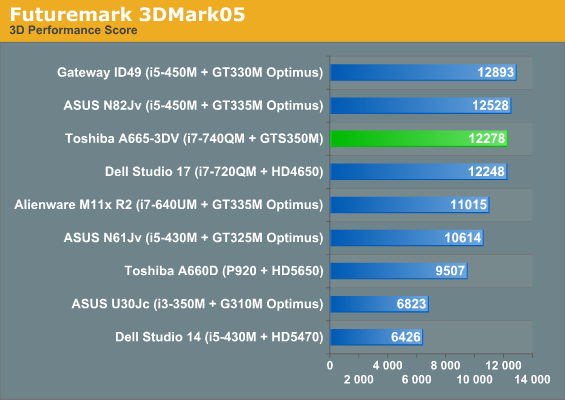
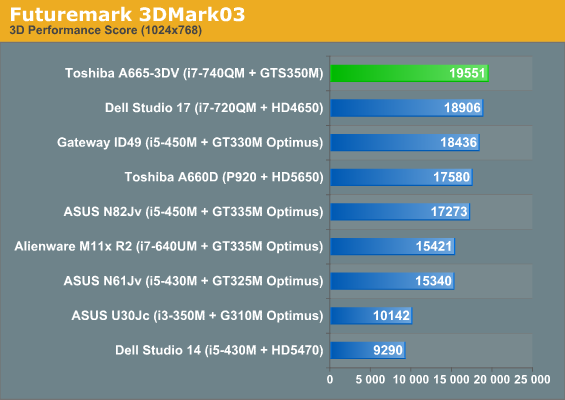
There's a love/hate relationship with most gamers and 3DMark. We don't consider it a replacement for gaming tests, obviously, but enough readers have requested the scores that we continue to post the results. Personally, I'd ignore the pre-3DMark06 results, but they provide a look at how fast older games will run. (Hint: More than fast enough!) As with the Low and Medium gaming results, 3DMark puts the GTS 350M above the other midrange GPUs, with the exception of the odd 3DMark05 result where the Gateway ID49C and ASUS N82Jv come out on top.
Big Battery for Okay Battery Life
With relatively high-end components and no switchable graphics, battery life is understandably not going to set any records. However, Toshiba does make some amends here by stuffing in a gigantic 12-cell 98Wh battery. The result is that while the system uses quite a bit of power, it can still manage over four hours of battery life in ideal circumstances. We set the CPU for 0% performance (hey, a quad-core i7 with Hyper-Threading is still plenty fast even if locked to 933MHz) and calibrated the LCD to 100nits—58% for the A665-3DV.
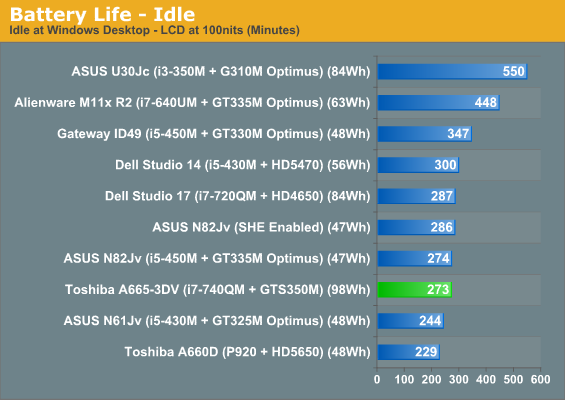
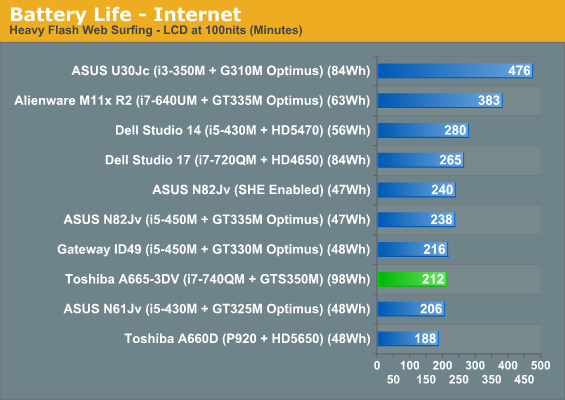
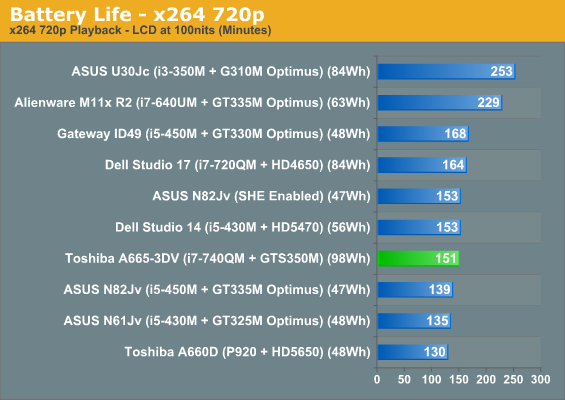
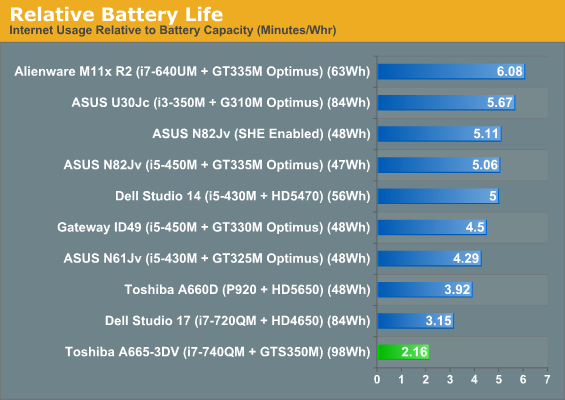
Considering the performance, battery life is actually quite respectable. 4.5 hours at idle, 3.5 hours for Internet use, and 2.5 hours of x264 playback manages to beat out the ASUS N61Jv and the AMD-based Toshiba A660D. The catch of course is that the battery capacity is literally twice that of many of the other laptops in our list. If you want all-day mobility, you're still better off with something like the ASUS U30Jc. However, if you're after a quad-core notebook with a fairly fast GPU, the A665-3DV acquits itself well enough. Note of course that in the relative battery life metric, it does place dead last out of the tested laptops, with the other quad-core i7 (Dell Studio 17) one rung up the ladder.
(Incidentally, we're also looking into the ASUS U35Jc battery life a bit more to see if we can figure out why our figures are so much worse than the U30Jc; other sites are reporting better battery life on the U35Jc, so we're running some additional tests to see if we can track down the cause/resolution.)
LCD Quality
Wrapping things up, we have our usual look at the LCD as well as some information on the noise and heat levels. The LCD story is a bit bipolar. On the one hand, the 120Hz refresh rate is a definite bonus, and we look forward to the day when all LCDs are (at least) 120Hz capable. Sadly, the other characteristics of the LCD are far less impressive, with average white levels and "gray" black levels, resulting in another poor contrast ratio.
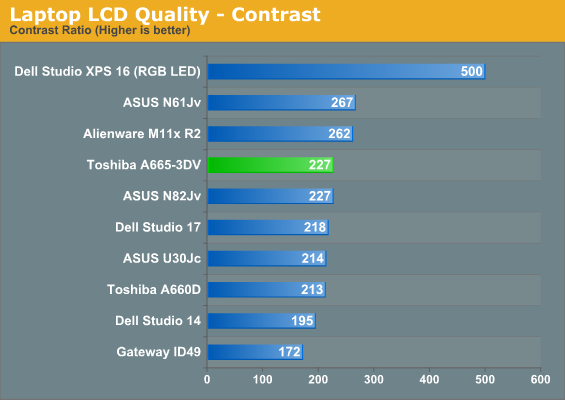
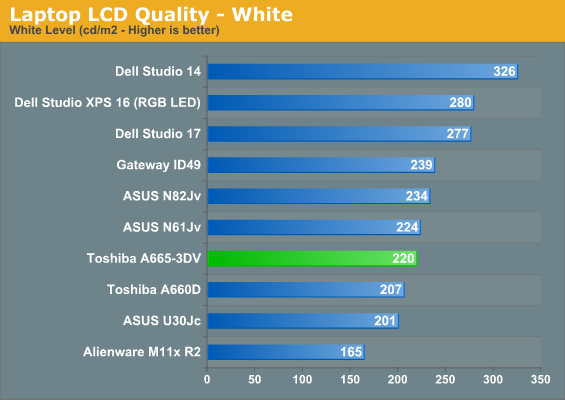
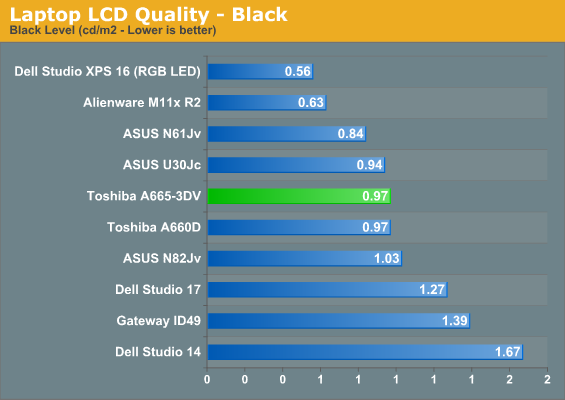
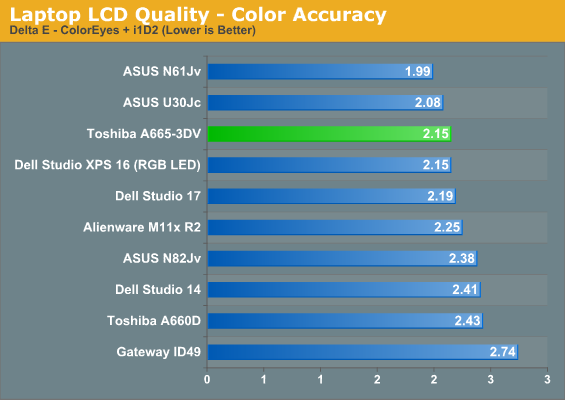
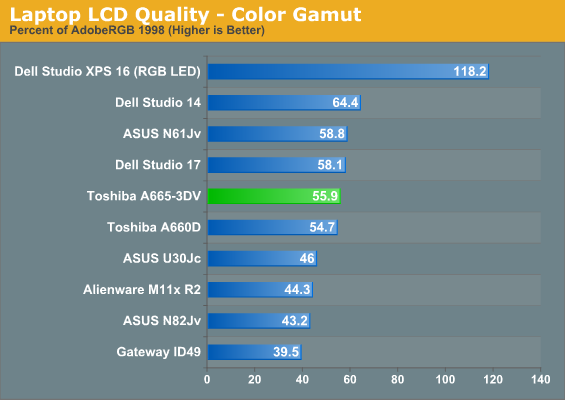

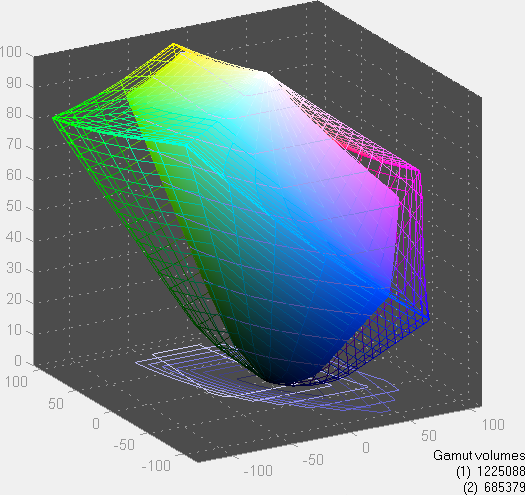
Color accuracy is okay but nothing special, while color gamut is a step up from the bottom level panels but still below the desired minimum 72% (NTSC) gamut. There's also the low 1366x768 resolution, but given the 3D features and how poorly games run in 3D even at 768p, we're not surprised Toshiba stayed away from the higher resolution panels. Also, the only other size 3D/120Hz laptop panel we're aware of is a 17.3" 1080p, so in this case the choices were extremely limited. The problem is, there's an emphasis on the 3D multimedia aspects of this notebook, and for multimedia work we'd really like a better quality LCD. Watching movies where dark scenes look more like gray isn't a great experience.
Noise and Heat
Surface temperatures are quite a bit cooler, but the left half of the laptop gets substantially warmer under load, topping out in the 40-45C range above and below the exhaust port. As you move to the right, there's a steady decline until you pass the middle of the laptop, after which the surface is in the <35C range (even under load). The bottom of the unit is typically a couple degrees warmer than the top, but nothing noteworthy. Noise levels hit a maximum of 40dB from 12", with idle noise of 33dB, which is near the limits of our equipment (30dB). Under light loads, the fan will periodically spin up and make itself heard, but it's not a major issue.
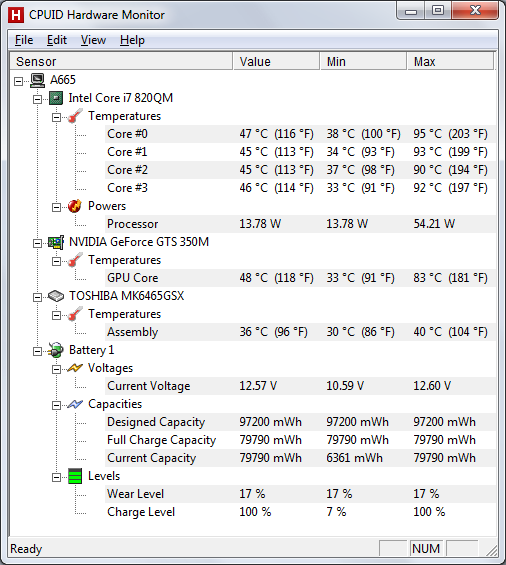
In response to a reader request, we've begun listing results from HWMonitor to show CPU/CPU core temperatures. GPU core temperature maxes out at 83C, which is fairly reasonable, while idle temperatures tend towards the upper 30s and lower 40s (the "min" result is taken shortly after powering on the system). CPU temperatures top out at 90-95C, again in spec but quite warm, with idle use hovering in the mid 40s. The hard drive also sits in the 35-40C range after the system has warmed up. One interesting item is the CPU power draw figure; we don't know how HWMonitor calculates the load, but the maximum 54.21W is 9W higher than the 740QM's 45W TDP. Whether that's accurate or not we can't say, but it is interesting nonetheless. As for the battery, the above readings were recorded after our three initial battery life tests; the first time we ran HWMonitor, wear level came up as 30%. A couple more cycles brought the wear level down to the expected range, seen below.
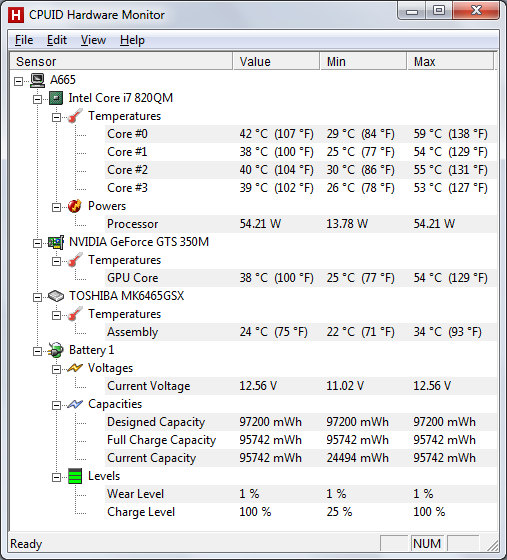
Results such as this are thankfully not the norm; most of our batteries come with an "initial" wear level of less than 3%, but the large 12-cell battery in the A665-3DV needed more time to break in. We had to rerun all the battery life tests after about five cycles, and our initial results were far worse than the final scores we showed.
Suffering the Slings and Arrows of a 3D Fortune
So what's there to say about the Toshiba A665-3DV? A lot, but much of what we have to say isn't that positive. The current (soon-to-be-outdated) 3D Vision notebook experience feels kludgy and tacked on with the A665-3DV, with a separate 3D emitter required. It usually works and when it does it looks fine, but on hardware like the GTS 350M it's more for movies and images than for gaming. If you buy a 3D camera like the Fuji Real 3D W1 we played around with, you can get some additional use out of the technology, which is good since finding new 3D content in other formats is sketchy right now. Honestly, my nearly eight-year-old daughter had far more fun with the 3D camera and display than I did; perhaps she's more easily impressed, or merely less jaded.
Given this is a $1400 laptop that uses the same chassis as the $750 A665D-S6051, build quality is another concern. We were iffy with build quality on the A660D with AMD components, and the similar A665D-6059 is priced at $800. Add $600 to the price and even with the improved performance we're left wanting more. Cheap, glossy plastic (with textures) is entry-level stuff, and the A665-3DV is not priced or spec'd as such. We said the 3D felt tacked on, and this is part of the problem with reusing designs. It was probably very easy to use the basic A665 design, swap out the 16" LCD for a 15.6" 120Hz panel, and add in a GTS 350M GPU. Easy, yes, but the resulting product isn't particularly compelling.
What you get with the A665-3DV is a reasonably fast midrange laptop, priced higher than other laptops sporting better components. The MSI GX640 we reviewed has a dual-core CPU, but the HD 5850 is substantially faster than the GTS 350M (with DX11 support as a bonus). It also has a better LCD and it's priced lower, though the keyboard is certainly a low point. There's also the ASUS G51Jx, with a GTS 360M (a nominal ~10% speed bump from the GTS 350M) and 720QM paired with a 1080p LCD; all that and you save $225 compared to the A665-3DV. However, pricing does warrant a closer examination.
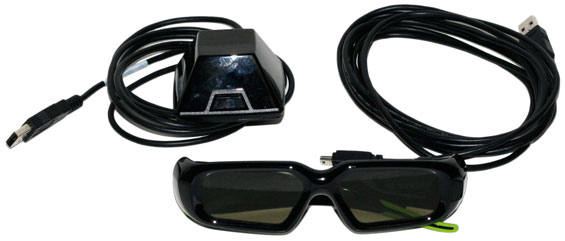
NVIDIA sells their 3D Vision package with the glasses and emitter as a $180 kit, so you have to include that in the price. That means we're really looking at a $1220 notebook with a 3D Vision kit—a slightly more palatable proposition. If you're comparing to the ASUS G51Jx we just mentioned, you also get Blu-ray support and ExpressCard from Toshiba (though ASUS offers what we can only assume is another questionable 768p 3D Vision laptop with the G51Jx 3D, priced at $1600+). But when the raison d'être of the A665-3DV is 3D and what we get is a half-baked attempt at 3D, this is a notebook that we can't really recommend. If you really like the concept of 3D movies, pictures, etc. you can give it a shot and it will work okay, but right now the 3D notebooks feel more gimmicky than useful.
The next generation 3D Vision with an integrated emitter will certainly help, but we really want a higher quality panel to go along with the other features—something that can do at least 500:1 contrast would be great, and while we normally wouldn't say this we also need a brighter LCD for 3D modes. With the shutter glasses, each eye only gets roughly half the luminance, so a panel that can put out more than 300 nits would be a good place to start. 3D Blu-ray is the other story here, and that means ideally you want a 1080p panel rather than downscaling content to a 768p display. If you want all that with 3D gaming, you're going to need much more than a GTS 350M; we'd say shooting for GT 445M would be the minimum, and preferably 460M or higher. We should see some notebooks in the near future that look to provide all of the above, but expect to pay a premium.
Given all the other features I want in a laptop, frankly, 3D support isn't high on my list. I'm happier with better performance, better battery life, a better LCD, better build quality and/or better portability, not to mention less eyestrain and no silly glasses… but I do have to admit that even without 3D, the 120Hz refresh rate is a nice extra. If you routinely attend the theater and spend the extra money for a 3D film, you might find 3D Vision laptops a better upsell, or you might prefer something like the ASRock 3D Vision HTPC Ganesh just reviewed. The rest of us should probably let the technology mature a bit longer before jumping on the 3D notebook bandwagon.


















